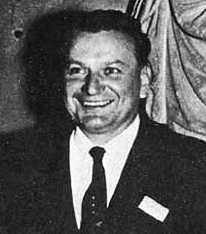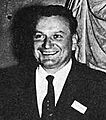Krafft Arnold Ehricke facts for kids
Quick facts for kids
Krafft Arnold Ehricke
|
|
|---|---|

Krafft Arnold Ehricke
|
|
| Born | March 24, 1917 Berlin, Germany
|
| Died | December 11, 1984 (aged 67) La Jolla, California, United States
|
Krafft Arnold Ehricke (born March 24, 1917 – died December 11, 1984) was a German engineer. He was an expert in rocket engines. He also strongly believed that humans should live in space. He worked on many important space projects.
Contents
Krafft Ehricke's Early Life and Education
Krafft Ehricke was born in Berlin, Germany. From a young age, he dreamed of space travel. A movie called Woman in the Moon inspired him greatly. When he was just 12, he even started his own rocket club! He later studied aeronautical engineering at a university in Berlin. He learned about how things move in space and about nuclear physics.
Working on Rockets in Germany and the US
From 1942 to 1945, Ehricke worked as an engineer in Peenemünde, Germany. He helped design rocket engines there. After World War II, he moved to the United States in 1947. This was part of "Operation Paperclip". Many German rocket scientists came to the US then. For a short time, he worked with the famous rocket scientist Wernher von Braun in Huntsville, Alabama.
Ideas for Space Exploration
In 1948, while working for the U.S. Army, Ehricke wrote a story. It was about a trip to Mars with a human crew. He thought about the challenges future explorers would face. In the same year, he wrote a book with Wernher von Braun. It was called The Mars Project. This book described how people could travel to Mars using a special ferry system.
After leaving government work, Ehricke joined Convair in 1952. There, he designed the D-1 Centaur. This was the world's first upper-stage rocket. It used liquid hydrogen and oxygen as fuel. He also designed an early space station. This station would have been launched by Convair's Atlas rocket.
Ehricke also worked on the NEXUS reusable rocket concept in the 1960s. This was a design for a very large rocket that could be used many times. He also took part in Project Orion (nuclear propulsion). This project explored using nuclear explosions to power a spacecraft.
Awards and Lunar Plans
In 1966, Krafft Ehricke was honored. He was added to the International Aerospace Hall of Fame. This was for his great engineering work. It also recognized his important ideas about exploring space.
Krafft Ehricke spent many years studying how to develop the Moon. He called the Moon Earth's "seventh continent." He imagined building cities on the Moon, like "Selenopolis." These cities would use advanced technology. They would even use nuclear fusion for power.
Krafft Ehricke's Legacy
Ehricke was very skilled in astrodynamics. This is the science of how spacecraft move in space. His books, called Space Flight, were very important. They helped explain how to explore our Solar System.
He showed how to use a method called "gravity assist". This method uses a planet's gravity to speed up or slow down a spacecraft. It helps spacecraft travel farther with less fuel. This technique made it possible to explore the outer planets. Missions like Voyager and New Horizons used this idea.
The Extraterrestrial Imperative
Ehricke had a special idea he called the "Extraterrestrial Imperative." He believed it was humanity's duty to explore space. He thought we should use the resources of the Solar System. This would help humanity keep growing and developing.
Ehricke believed there were no "limits to growth" for humans. He said that while Earth is a "closed system," space exploration opens up the whole universe. For him, human creativity had no end.
Krafft Ehricke had a space burial on April 21, 1997. A rocket sent a small amount of his ashes into orbit around Earth.
Images for kids


